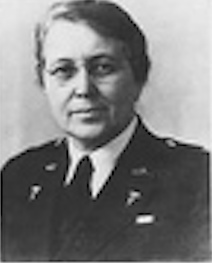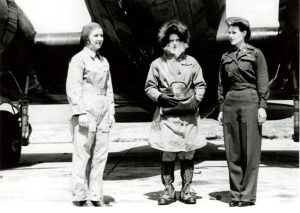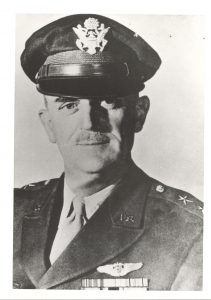The Aerial Nurse Corps of America
Part 5
Leaders of the American Red Cross (ARC) had been following the activities of pilot Lauretta Schimmoler and the Aerial Nurse Corps of America (ANCOA) closely ever since her organization had “gotten off the ground” in the 1930s. Officials of the ARC questioned Schimmoler’s motives. First, she continued to imply a connection between the two organizations when in fact the ANCOA was in no way connected with the ARC. Second, Schimmoler was a pilot, not a nurse. Third, she had made enrollment in the First Reserve of the ARC a requirement for membership in the ANCOA. And fourth, Schimmoler had not actually communicated with ARC National Headquarters concerning her organization until 1937. As will be seen below, however, this last point is open to question. These issues were the topics of much correspondence among ARC personnel beginning that same year.
“My Dear Mrs. Carter”, wrote Ida F. Butler, Director of Nursing for the ARC, to the Chief of the Nursing Division, League of Red Cross Societies in Paris, on 30 August 1937, “It is pleasant to receive a letter from you and I am particularly interested in its contents about this Aerial Nurse Corps of America because it has not yet been officially recognized by the American Nurses’ Association, in fact I am quite sure that the President and Founder, Lauretta M. Schimmoler, is not a nurse.”
Butler told Carter that she had written to Mrs. Alma H. Scott, Director of the American Nurses’ Association [ANA], at her New York headquarters not only on the question of the ARC recognizing the ANCOA but also “whether the ANA would take any cognizance of the organization”. Butler’s letter to Carter continued:
The first correspondence indicated that they were going to call the Corps the “American Red Cross of the Air” and, of course, I immediately discussed this with our Legal Advisor because we would not have permitted that title to be used but I notice that they are calling it the “Aerial Nurse Corps of America” so the Red Cross has no reason for complaint except that I believe we should be consulted before they use the membership in the American Red Cross Nursing Service as one of their requirements for an appointment. 1
A few days later on 3 September 1937, Butler wrote to Gladyce L. Badger, Director of Nursing for the Pacific Branch of the ARC, to see if Badger could secure additional information on the ANCOA, particularly an application form. The ARC legal advisor, Mr. Hughes, had advised Butler not to write to Schimmoler directly, as the letter “might be construed and might be used for publicity in a way of which we would not approve”. 2 Because of her position on the Board of Directors of the ANA, Butler had been allowed to read all the confidential information on this organization on file at the Headquarters Office of the ANA in New York City, Butler confided to Badger:
Among the letters on file was one from Miss Nellie Porter who has, I believe, held prominent positions in the California State Nurses’ Association. Miss Porter informs us that the woman in question is a promoter, while lacking culture and education [she] seems to have a certain amount of personality. … I find that among the requirements for admission to the Aerial Nurse Corps is enrollment in the Red Cross Nursing Service. They also require the candidates to have had our courses in First Aid and Life Saving.
In spite of all this there has never been any informational material or any correspondence from Miss Schimmoler. The Army Nurse Corps has also been interested because the name which this organization has taken uses the initials of the Corps “A.N.C.” Also in dividing up the country into Aerial Corps territories they have used “Corps Areas” which is the Army term for the division of the states into Army Corps Areas. 3
On the surface, Butler espoused the official stand of the Army Nurse Corps and the ARC concerning the ANCOA but confidentially shared her own view with Badger that
we have all decided that at the present time we have no interest and certainly no “case” against this organization. Though confidentially I think we might have stepped into this breech and made an offer ahead of this woman to help the commercial planes in selecting well trained nurses for this service. 4
Butler then shared with Carter what she had learned during her visit to the National Headquarters of the ANA:
For your confidential information, I have seen a great deal of correspondence, especially from the Secretary of the California State Nurses’ Association which throws considerable light on the organizer of the [Aerial Nurse] Corps. She is not a nurse, is a great promoter with the ability to attract because of her personality but she is not a woman of either culture or education and it is a very great surprise to me that nurses with high standards of education and enrolled in the Red Cross Nursing Service would be willing to organize with a leader who is not one of their professional group.
After consultation with Mrs. Scott, I have decided to discuss with our Legal Advisor, Mr. Hughes, whether I would in any way be entangling the Red Cross if I were to write to the promoter of this organization, Miss Lauretta M. Schimmoler, expressing my surprise that she would not have communicated with the Director of the Red Cross Nursing Service before making through her literature the requirement that she had made enrollment in the Red Cross Nursing Service one of the requirements for membership in the Corps, and also the requirement that the applicant shall have had the Red Cross First Aid and Life Saving Course. I will make the letter, of course, as friendly as possible and ask for further information as we are interested. 5
Butler then told Carter that she had spoken with Major Julia C. Flikke, Superintendent of the Army Nurse Corps, about the similarity of the Aerial Nurse Corps to the Army organization. Butler’s understanding was that Flikke had been advised by her commanding officer “that at the present time they should ignore the [ANCOA] organization and not raise the question of the confusion that may eventually ensue because of the use of Army terms”. 6
Writing to medical historian Hubert A. Coleman in March 1945 about the Aerial Nurse Corps of America, Schimmoler recalled that she had communicated with the ARC as early as 1932 in a letter to Clara Noyes, Director of the ARC Nursing Service to inquire
if I were to assemble a number of nurses for the purpose of giving them aeronautical training to equip them for air ambulance duties, if I would be contributing to the service of my country. I was informed that it was doubtful that nurses would ever fly, if so they would probably fly in government airplanes and would not require special training. 7
The wording of Schimmoler’s letter to and reply from Noyes, as Schimmoler later remembered it, resembles the wording of a letter and its reply that she recalled in a separate undated account of ANCOA written after 1944 in which she asked the Army Nursing Service: “’If I were to interest nurses and train them for air duty, would I be rendering my country a service?’ The reply stated in part, ‘I don’t think nurses will ever fly, and if they do, they will fly in government airplanes and won’t need any special training’.” 8
Whether or not Schimmoler actually had corresponded with the ARC in the 1930s, the growing distress over the activities of Schimmoler and the ANCOA prompted Butler to discuss the matter with the Chairman of the ARC, Admiral Cary T. Grayson. At his request, Butler drafted a letter for his signature to the Surgeon General of the Army, Major General Charles R. Reynolds, stating that the Red Cross stood ready to organize an aerial corps of their nurses if the Surgeon General thought it would be a good plan toward preparedness. 9 Reynolds’s reply discouraged pursuing this option for the time being:
At the present time we look upon nursing in connection with Air Corps activities as a specialty only comparable with certain other features of surgical nursing and do not believe that a special corps of aerial nurses should be trained in the military service or in civil life, especially by an organization independent of the American Red Cross.
We recognize the fact that the airplane will be used as a transportation agency in time of war and it may be that especially in the secondary evacuation in the rear area or the theater of operations and in home territory there may be a need for specially trained nurses. However, this need will not exist, in my opinion, in the combat zone, or at least the employment of women nurses for front line evacuation will not be required. 10
He did recommend, however, that he and Grayson discuss the matter in more detail “first to provide adequately and reasonably to meet known conditions or those to be expected and, more particularly, to forestall activities on the part of unaffiliated auxiliaries in this country in the field which offers more romance than war has ever seen before”. 11
A few months later Schimmoler, who continued to seek Army recognition of the ANCOA, appealed to Major Flikke for support. In her letter Schimmoler included a four-page summary of the objectives and accomplishments of the ANCOA and ended her correspondence with the hope
that this statement of our work and objectives will be of interest to you and convince you that the work warrants your good will. Your suggestions and cooperation are invited, to assist the patriotic young women of this organization to better equip themselves to assist in furthering the interests of commercial aviation in time of peace, and providing for them a definite palce [sic] in the scheme of national defense in the event of a major national emergency. Your suggestions on this last phase of our work are particularly desirable. 12
Flikke’s reply to Schimmoler was not encouraging:
It is of course an undisputed fact that aerial travel is of very vital importance and will become increasingly more so in the future. From your letter and other information that has come to me unofficially during the past few months, it would seem that you have a very well planned organization and if the motive is to care for commercial and aerial transportation, your success is no doubt assured.
In the Army, however, we have a well organized corps of nurses and flying is not unknown to them. I venture to say that the majority of them have experienced the thrill of traveling by air, and when necessary to transport a patient from one section of the country to a hospital some distance away, a doctor and a nurse board a plane and accompany the patient. To us a nurse on a transport plane is like any nurse having a special assignment; such as being a surgical nurse, anesthetist, laboratory technician, etc. In times of peace very few calls are made for such assignments and if we should become involved in a conflict of some kind, any well trained nurse to whom air travel is not distasteful could be so assigned, so that at the present time at least there seems to be no factual justification for a group of nurses being segregated and called aerial nurses. Nor does it seem advisable to have two organizations with such similar nomenclature that confusion may result therefrom.
As you know, the reserve nurses for the Federal services have always been supplied by the American Red Cross – a practice which we hope will always obtain. Perfect harmony and co-operation exist between the Army, Navy and Red Cross, and efficient service has always been rendered. 13

Julia Flikke [US Govt Photo]
Again, military recognition of the ANCOA was not granted. Flikke made it clear that the similarity between Schimmoler’s organization and that of the Army was not appreciated. Furthermore, the letter reiterated that nurses supplied to the Army for any military need would come from the ARC First Reserve, not from the ANCOA. Flikke apparently had sent a copy of her letter to Schimmoler, as well as information about the ANCOA, to Butler of the ARC who replied, “After reading it, I am very skeptical about the soundness of the organization and I believe that you and I are following the safe course in not committing ourselves. Your letter in reply to Miss Schimmoler’s was very fine.” 14
The rejection of her coveted goals only made Schimmoler more determined to succeed, as Mary Beard, who had succeeded Butler as Director of Nursing of the ARC, soon discovered. In a letter to Mr. Hughes, the legal advisor, Beard expressed her concern that the ANCOA organization’s activities
have been growing more and more aggressive. Miss Schimmoler, who is not a nurse, is being almost Deified as the great founder of this organization. The disconcerting thing is that she is using the Red Cross to advertise her project, using it in little “un-get-at-able” ways such as a notice of a meeting, when on the first line appears “Red Cross Nurses” and then in smaller print “are interested in ***.”
Rather recently we have heard of active efforts to organize in New York where an enrolled Red Cross nurse is helping to promote it. Miss Schimmoler is trying to get a large group within her Aerial Nurse Corps of America to enroll in the Red Cross first reserve. This, of course, is a laudable idea but not when it promotes a nurse reserve outside the Red Cross and which is growing so fast. You remember we consulted both the Army and Navy to know whether they wanted the Red Cross to go in for this sort of a reserve for them and they said no. Would you be willing to talk with me about it again? 15
Beard must have heard directly from Schimmoler shortly thereafter, because a memo from Beard to Hughes dated a month later expressed the double bind in which Beard found herself regarding manipulative tactics employed by the ANCOA leader:
Miss Schimmoler seems determined to “draw” us in regard to this aerial service.
1. If we reply to this letter approving of what these nurses are doing, she will undoubtedly give publicity to this approval.
2. If we do not approve it, she will publish this disapproval and I do not like either position.
I shall be very grateful for your help. 16
Shortly thereafter, Virginia Dunbar,Beard’s assistant at ARC Headquarters, compiled a summary of statements made about the ANCOA in literature and letters, which she sent to her boss, shedding additional light on Schimmoler’s public relations efforts on behalf of her organization. Dunbar’s cover letter revealed her own opinion on the matter:
As I read all of the material of the Aerial Nurse Corps of America (Newspaper clippings, letters, printed bulletins, etc.) I was impressed with the number of references to the Red Cross. Some of the notices were very short so that a reference to the Red Cross stood out. I felt that the statements were decidedly misleading as they certainly inferred a connection with the Red Cross (and the Army). 17
Armed with the latest information on ANCOA, Beard wrote Schimmoler, stressing the separateness of the two organizations and the role of the Red Cross alone to provide nurses for the military, even for aviation duty:
You were kind enough also to give us assurances of the desire of your group to cooperate fully with our society. There is, we believe, a practical method in which this cooperation may be made effective, namely by exercising constant care to have the public fully appreciate the special and separate fields in which both of our organizations are engaged. As you know, we maintain a reserve of nurses who may be needed for duty with the United States Army and Navy. If and when there be need by these branches of the Government for nurses especially trained in aviation matters, the Red Cross will proceed promptly to meet this need.
In the meantime, it would be unfortunate if those directly connected with nursing and the public in general did not clearly understand the respective services which both of our organizations are fostering. 18
To be continued
Notes
1 Ida F. Butler, letter to Mrs. Maynard L. Carter, 30 Aug 1937.
2 Ida F. Butler, letter to Gladyce L.Badger, 3 Sep 1937.
3 Ibid.
4 Ibid.
5 Ida F. Butler, letter to Mrs. Maynard Carter, 17 Sep 1937.
6 Ibid.
7 Lauretta M. Schimmoler, letter to H.A. Coleman, 22 Mar 1945.
8 Lauretta M. Schimmoler, “The Story of How It All Began: ‘And They Said It Wouldn’t Be Done’,” unpublished manuscript, n.d., 4. [Bucyrus, OH Historical Society]
9 Cary T. Grayson, letter to Charles R. Reynolds, 25 Oct 1937.
10 Charles R. Reynolds, letter to Cary T. Grayson, 29 Oct 1937.
11 Ibid.
12 Lauretta M. Schimmoler, letter to Julia O. Flikke, 23 Apr 1938.
13 Julia O. Flikke, letter to Lauretta M. Schimmoler, 29 Apr 1938.
14 Ida F. Butler, letter to Julia O. Flikke, 28 May 1938.
15 Mary Beard, letter to Mr. Hughes, 31 Mar 1939.
16 Mary Beard, letter to Mr. Hughes, 1 May 1939.
17 Virginia M. Dunbar, letter to Mary Beard, 1 Jun 1939.
18 Mary Beard, letter to Lauretta M. Schimmoler, 7 Jul 1939.



